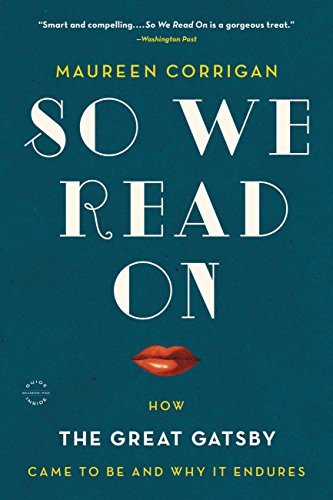What do you think?
Rate this book


350 pages, Kindle Edition
First published September 9, 2014

Julian Boyd, then Princeton’s University librarian, refused to raise the bid and, according to Randall, said something along the lines of “Princeton was not a charitable institution, nor was its library established to support indigent widows of, and I quote, ‘second rate, Midwest hacks,’ just because they happen to have been lucky enough to have attended Princeton – unfortunately for Princeton.”
"That's why Nick Carraway, like generations of the book's readers, is so haunted by Gatsby: Gatsby reached out, strained the farthest, ran the fastest trying to grasp something while everyone else in the novel was anesthetized by liquor or greedy self-regard."
Gatsby believed in the green light, the orgastic future that year by year recedes before us. It eluded us then, but that's no matter--tomorrow we will run faster, stretch our arms out farther. . . . And one fine morning--
So we beat on, boats against the current, borne back ceaselessly to the past."
Americans' quotidian desire for achieving the American dream of fortune, fame and happy family;Ms. Corrigan also provides an intriguing examination of the author's tragic life and death and analyzes why, like many supremely talented artists before him, F. Scott Fitzgerald died in the depths of depression and perceived by himself and many others as a mediocre has-been, with his masterpiece largely unrecognized until several years thereafter. And yet, it endures as the most studied piece of literature in U.S. secondary education.
Americans' yen for desire itself ("there are only the pursued, the pursuing, the busy and the tired"); and
Our quixotic beliefs, or romantic notions, that we can somehow relive the past, especially to recapture lost love or to win love long unrequited (Gatsby to Nick, "Can't repeat the past? ... Why of course you can!").
F. Scott Fitzgerald wrote what is arguably the Great American Novel, but died believing himself to be a failure. In So We Read On: How the Great Gatsby Came to Be and Why it Endures, Maureen Corrigan shares her deep love and understanding of this complex, intricately-structured novel. She also provides insights into Fitzgerald’s life as he wrote, and obsessively re-wrote, his most celebrated work. Here’s Maureen poring over Fitzgerald’s personal copy of the first edition of Gatsby in the Fitzgerald Papers at Princeton University:
“A tireless re-reader of his own novel, Fitzgerald has marked up in pencil almost every thick, soft page of this Gatsby... there are the changes; lots of little changes. Precisely because almost every one of these changes is so incidental, I find them touching. Fitzgerald is such a perfectionist, he just can’t let go. These changes were picked up in subsequent editions so that Gatsby got closer and closer to Fitzgerald’s Platonic ideal of the novel.”
Maureen Corrigan also outlines many aspects of Gatsby which may escape the casual reader, such as the motif of water and drowning; the many references to time; the subtle markers of class; and the parallels with the real New York of the 1920s. The wealth of fascinating details and fresh insights will encourage Gatsby fans to re-read the novel again and again — and in fact, Maureen says she is still discovering new aspects of the book, even after lecturing about it for several decades.
In a feat of literary detective work, she traces the resurgence of interest in The Great Gatsby, in part, to its inclusion in the special Armed Services Edition paperbacks which were issued to American services personnel during World War II. It’s a sad irony that the first print-run of Gatsby sold only 23,000 copies and much of the second printing remained in the publisher’s warehouse at the time of Fitzgerald’s death in 1940, but five years later, 155,000 paperback editions — each designed to be read about seven times — were distributed to servicemen. As Maureen Corrigan remarks:
“Even if some of those [Armed Services Edition] estimated readings are inflated, one of the things some of those World War II servicemen carried with them back home was an awakened interest in F. Scott Fitzgerald.”
I thoroughly enjoyed reading the story behind The Great Gatsby, the detailed analysis of the novel, and the insights into Fitzgerald’s life and times. But what prevents me from giving So We Read On a five-star rating is the sense that Maureen Corrigan didn’t benefit from the kind of high-calibre editor who worked with her literary idol.
For example, she mars an anecdote about a Great Gatsby Boat Tour with a mean-spirited criticism of the tour guide:
“a cheery middle-aged woman who tells us that... she took Baz Luhrmann and his wife, costume designer Catherine Martin, out on Manhasset Bay to tour the Eggs in 2008 in preparation for Luhrmann’s Gatsby film. Despite these credentials, she’s relying on notecards to give the bare bones of Fitzgerald’s biography.”
Chapter 3, “Rhapsody in Noir”, makes a convincing argument for Gatsby as a “near relation of the hard-boiled novel”, which:
“derives from the very same urban American sources that inspired the gals-guts-and-guns school of fiction that evolved into the pulp magazines of the early to mid-1920s”.
While this is an interesting analysis, Corrigan uses the term “hard-boiled” so many times in this chapter — even twice in one sentence! — that I found myself reaching for the editorial red pen.
As well, there’s more than a whiff of condescension as Corrigan refers to the “plebeian” readers and reviewers of Fitzgerald’s work. It’s a shame that the intrusion of her own biases spoil such a valuable and absorbing guide to The Great Gatsby and its enduring power over generations of readers.